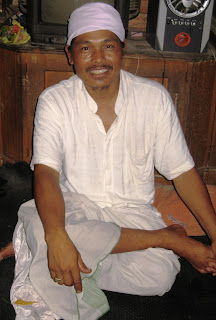Jero Mangku Made Rata
Jero Mangku Made Rata has such an easy way about him that I like him immediately, no reservations. A solid 50-years-old guy, graying hair pulled into a bun with a ready smile and a satchel filled with his bottles of oil, he looks prepared for anything. He has come to our villa to treat my friend Ria who is visiting us from Hawaii. Like Slava, Ria also has a problem with her feet. As Jero gives her the full treatment, he finds other parts to heal as well. He tells her she is very "pure." Although Ria is a vegetarian, I don't think he's referring to that because he sees no problem with eating meat or smoking cigarettes. Jero derives his power from meditation and he picked up on Ria's daily meditations. The pain, though, is more than Ria likes, so he gives her his "western people treatment." "Balinese people can take a lot more pain," he jokes. What would need only one treatment for a Balinese requires three for a westerner, which is fine with Ria, as long as she gets the desired result. And she does, plus a few more unexpected bonuses.
The first time I ask Jero how he became a healer, he answers "Meditation." I'm disappointed. You know me, I like a more dramatic story. Like the one about the farmer who found a dead baby girl on his land (most likely aborted - more about abortions later). He buried her with the required rites but then went further, acting as if she were still alive, and honoring her with every ceremony needed for a child growing up strong and healthy. The story goes that indeed the girl grows up in heaven and is in constant communication with him. When someone falls ill, she tells him what the person needs to get well. And that's how he becomes a healer. The girl is now a grown woman, beautiful and happily married - all in heaven, of course. Through her he can also speak with the dead. The people who told me about him promised to take me to him next time they go. I look forward to that.
Back to Jero Made Rata. When he comes over to treat Phil, I take another stab at it.
"What kind of meditation do you practice?" I ask.
"A mantra." he answers, "I have a meditation center and many students."
"Can you teach us? Can you give Phil and me your mantra?"
"Yes."
"Do we have to come to your meditation center?"
"No, I can give it to you now."
By the way, the above is a liberal translation of our conversation because Jero Made Rata does not speak English. Even though I can pretty well understand him (Yes, my Indonesian is picking up - Yay!), I still like to have Dayu present to translate the finer points. When I go to Jero Ardita, Suamba serves as my translator.
Jero Made Rata gives us his basic mantra, an easily-remembered 4 lines of Sanskrit that we are free to translate into English as long as we keep the feeling of the mantra in our heart. Then he has Dayu fill two glasses with water and pick 5 flowers of different colors for each of us from our garden. Taking one flower at a time, he silently blesses it with a mantra and places it inside the glass of water. The flower water looks beautiful.
"Drink." He says, "Leave a bottom of water in your glass."
As I bring the glass to my lips I'm overcome with the perfume of flowers. It is as if all the flowers in the world have gathered their essence into my glass. The taste of the water surprises me too. This is not like our regular bottled water. This is unexpectedly sweet, like drinking Maroccan rose water. When I mention my surprise, Jero smiles and says that I'm tasting the mantra.
He then instructs us to pour the last bit of water in our hands and "wash" our face with it, three times. At night we're to say the mantra three times and meditate. He does not specify how long.
Phil drinking his 5-flower water
Jero invites me to come to the Full Moon ceremony at his compound. Not knowing if it requires sitting for long periods on the floor, Phil opts out and I take Dayu with me instead. I don't like wearing sarong and kebaya, they're hot and constricting, but if I want to take photos of the ceremony I must be properly dressed to enter the temple. It turns out I didn't have to bother.
Suamba drives us out to Saka Village, about 20 minutes away and we easily find Jero's compound. Motorcycles line the entrance like dominoes waiting to get kicked over. When we enter, Jero is already in ceremony, his back turned to us. What he calls his meditation center is a small pavilion where he also does his healings. It is presently occupied by three of his students in various stages of massaging patients. The back wall of the pavilion is ludicrously stacked with cabinets, an old but working TV and two humongous speakers. The TV is on but thankfully muted. The courtyard is filled with groups of people sitting quietly on mats, benches, and old chairs. Some are smoking. Bird cages without birds hang from rafters and tree branches. A laundry rack displays drying T-shirts. Here and there a couple more motorcycles. A small boy and his grandma are watching TV on a side terrace. Chickens, dogs, and a cat roam amidst the chaos. I must be adapting to Bali because I like it.
To be continued...
.










No comments:
Post a Comment